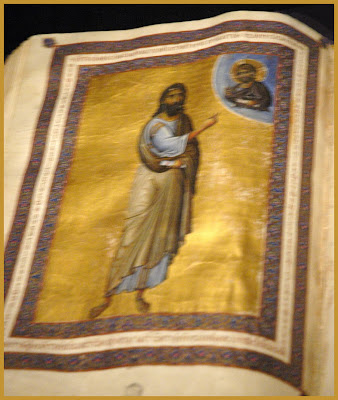This is post # 7 in my series on the Sackler exhibit: "In the Beginning: Bibles before the Year 1000"; for the preceding post (# 6), click
here. I am nearing the end of this series: We are moving to its last section, which showcases the Bible as "Icon." By the fifth and sixth centuries ce, Bibles were becoming much more opulent. By the year 1000, the appearance of volumes such as the Niketas Bible virtually embodied their achieved status as God's powerful, unified Word.

The book that really caught our eye as we moved to this section of the Sackler exhibit was The Major Prophets, otherwise known as The Niketas Bible. This volume, containing Jeremiah, now owned by the Biblioteca Medicea in Florence, was created in Constantinople in the second half of the 10th century ce. Its contents include the text of Jeremiah in Greek, commentary known as "catena," exposition of the prophet's life, and the full-page portrait of the prophet shown above. A courtier known as Niketas used imagination and study of older exemplary Bibles to produce the grand volume, with its classical artistry and aura of majesty.
Here (below) is a detail, showing the amazing face of Jeremiah. There is an emotional intensity about his face, well in keeping with his tragic mission and personal suffering.

From a theological perspective, the two-way interaction of Jeremiah and Jesus here is fascinatingly instructive. On the one hand, Jeremiah points ahead to Christ, the coming messiah. His inspired prophecy foresaw Christ's day, which lay hundreds of years in the future.
On the other hand, Christ is already present to Jeremiah. The image captures the act of Jeremiah receiving Christ's divine inspiration. This is nicely symbolized by the scroll in Christ's left hand and Christ's gaze and gesture.
The modernist approach to biblical study has much less trouble with the first half of this two-way interaction than with the second. Historical critics can usually accept that Jeremiah, or at least his editors, may have hoped for the coming of an ideal ruler, the messiah. Modernists almost always fall short, however, in giving adequate voice to the second half of the interaction. The messiah for whom he hoped was, in a profoundly real theological sense, already present to Jeremiah! Christians can and must grow theologically from attending to Jeremiah's witness to this Word, to his revelations about Jesus Christ.


0 Comments:
Post a Comment
<< Home